From high-altitude mountain villages and whitewashed pueblos blancos to charming seaside settlements and beach towns, here are 18 of the most beautiful Spanish villages and small towns to add to your Spain travel wish list.
Please note: This post contains affiliate links, meaning I may earn a commission if you make a purchase by clicking a link (at no extra cost to you). Learn more.
18 Beautiful Spanish Villages & Small Towns: From Aragon to Extremadura
Planning a road trip around Spain? In addition to the big cities and top tourist attractions, be sure to include a few of these beguiling villages, lesser-known towns and hidden gems on your Spain itinerary.
Here’s where to beat the crowds, discover rural life and learn about Spanish history – and where to find the best cuisine, incredible festivals, empty beaches, remote mountains, and romantic cobblestone streets.
1. Setenil de las Bodegas, Andalusia
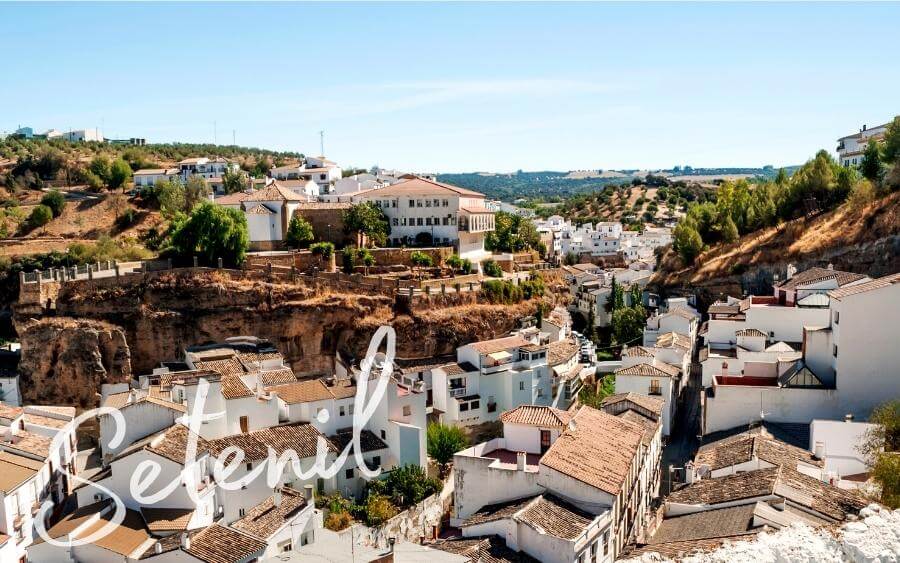
There’s no other place quite like Setenil de las Bodegas in far-Southern Spain’s Cádiz province. This beautiful town of less than 3,000 people is known for its ‘cave houses’, dwellings built directly into craggy rock overhangs along the Río Guadalporcún river.
Setenil started life as a fortified Moorish town. In the 15th century, Christian settlers started growing wine grapes in the area alongside olives and almonds. The surplus of bodega wineries that sprung up gave the settlement its new name. (Sadly the vines were wiped out in the 1860s.)
The town’s legacy as a foodie hotspot and important supplier of produce to the region lives on, and Setenil is known for various specialty foods including chorizo sausage and pasteles.
After sampling some of the region’s best nibbles at bars and restaurants shaded by the rocky cliffs, walk the cobblestoned streets to find the Church of La Encarnacion, Nezari Castle, and other important landmarks. Climb up to the Mirador on San Sebastian for amazing views of the houses and cliffs.
2. Castellfollit de la Roca, Catalonia: One of Spain’s most picturesque villages
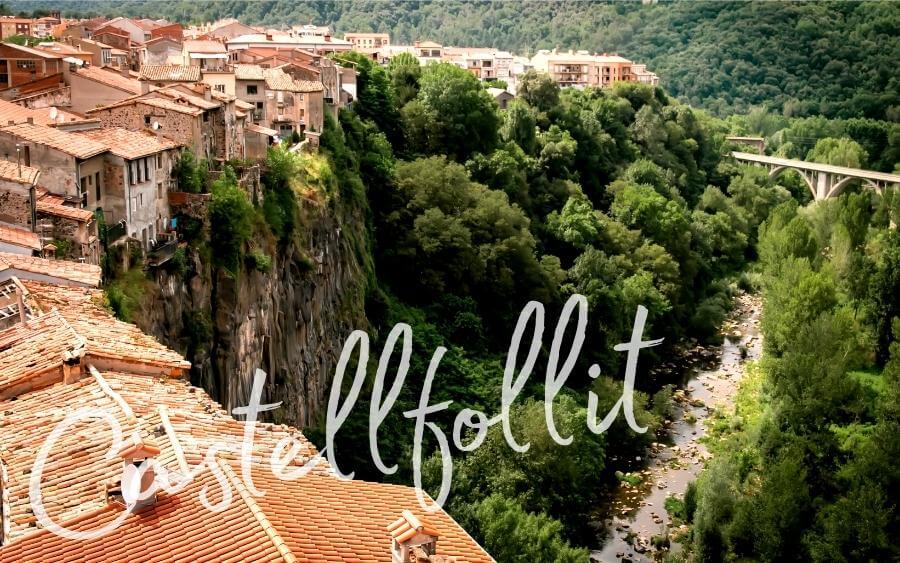
Set in the spectacular La Garrotxa Volcanic Zone Natural Park, with its estimated 40 dormant volcanoes and lava fields, Castellfollit de la Roca is one of the most picturesque spots in the entire country. Just a two-hour drive from Barcelona (or 45 minutes from the underrated city of Girona), it’s an ideal day trip destination for hiking and magnificent views.
Castellfollit de la Roca has been inhabited since medieval times. It sits between basalt rock cliffs formed by lava flows at the confluence of the Fluvià and Toronell rivers. Many of the narrow streets and squares in the historic village centre were built from volcanic rock quarried nearby, which makes Castellfollit blend perfectly into its surroundings.
Don’t miss the 11th century Romanesque church of Sant Salvador, perched precariously on the cliffside. After exploring the landscape and streets on foot, a cold craft beer at Poch’s Cervesa Artesana, the village’s very own microbrewery, is just the thing to relax.
3. Albarracin, Aragon
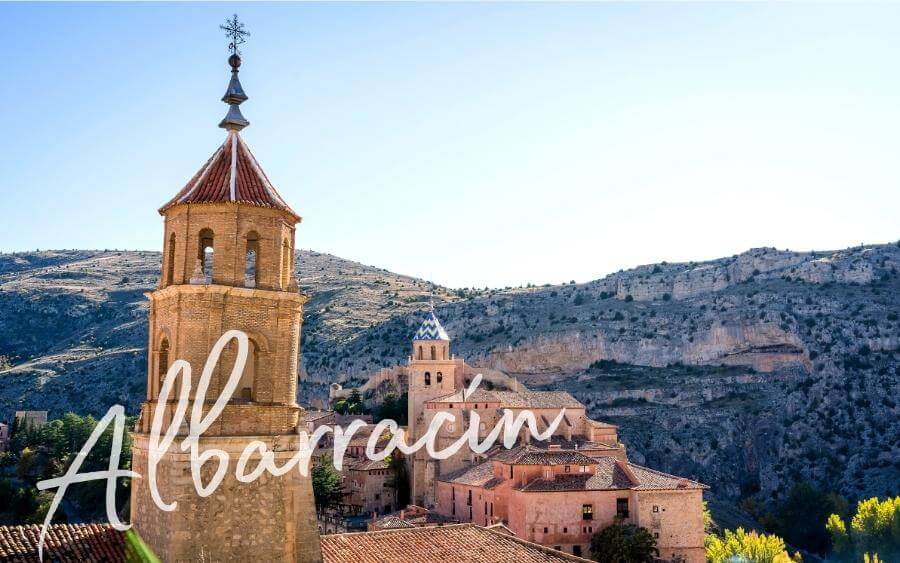
Albarracín is a tiny town of 1,000 people on the edge of the Parque Natural de la Serranía de Cuenca, around 4 hours by road from Madrid. Enclosed by sandstone cliffs and boulders, it’s an extremely popular destination among rock climbers.
The blush-coloured stone of the nearby UNESCO-Listed Pinares de Rodeno is used in many of Albarracin’s buildings, giving the Moorish-meets-medieval town its rosy hue. The historic quarter offers delights at every turn, from the Murallas de Albarracín (medieval walls) and the Andador Tower, to the Plaza Mayor, the ruins of the Moorish castle, and the 16th-century Salvador Cathedral.
For something different, visit the local museum that catalogues the village’s medieval history through currency and ancient parchments. Albarracin is a gateway to more beautiful villages around Aragon and an ideal base for exploring.
4. Alcala del Jucar, Castilla la Mancha
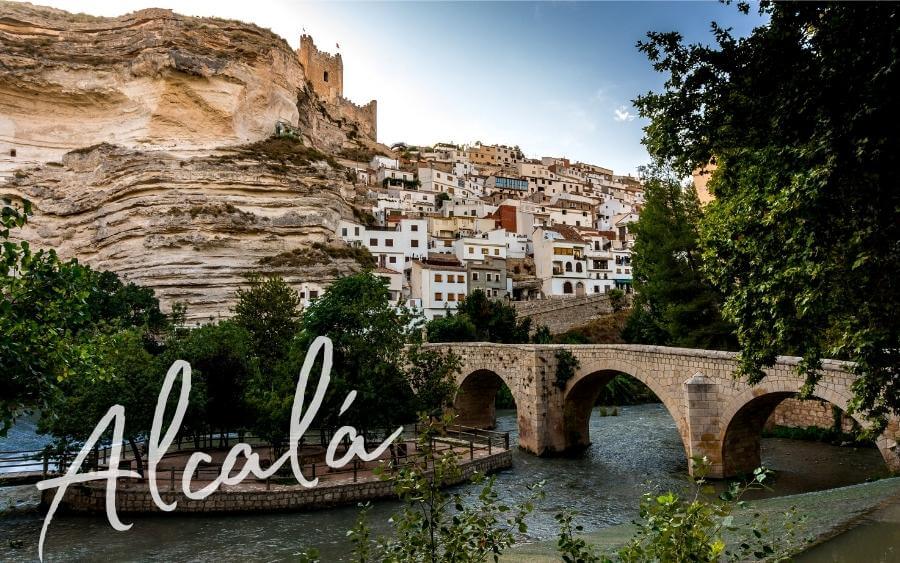
The elegant Puente Romano stone bridge welcomes visitors into Alcalá del Júcar, surely one of the most romantic towns in Spain. From panoramic viewpoints to cosy cafes and bars set inside caves, this place has something for every traveller and every season.
Built adjacent to a cliff wall, above the Júcar river, Alcala is a fairytale-like scene of narrow streets and whitewashed houses that cling to the rock wall. The 15th-century San Andrés church, with its Gothic and Neoclassical flourishes, should be your first port of call after crossing the river.
Wind your way up through the canyon through the tight-knit maze of houses all the way to the Vistas panorámicas de Alcalá del Júcar, the best viewpoint in town. On the western side of the village, the Castillo de Alcalá del Júcar castle is another must-visit.
5. Sos del Rey Catolico, Aragon
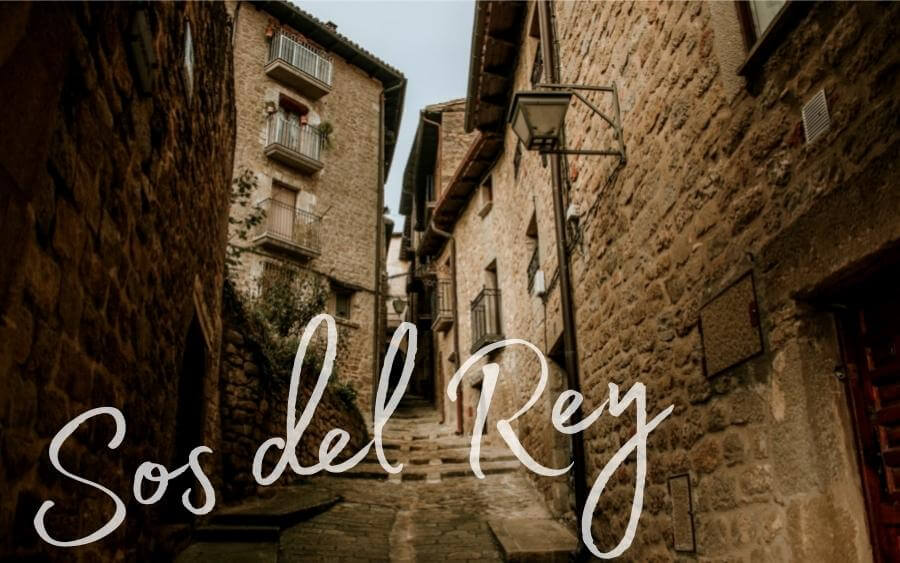
When you picture an archetypal red-roofed Spanish village, Sos del Rey Católico is probably what comes to mind. This little town is located on the frontier of the Pyrenees 1.5 hours’ drive north of Zaragoza.
Formerly part of the Kingdom of Aragon, the town dates back to the year 907 when it served as a fortress. Ferdinand II of Aragón, husband of Isabel I of Castilla and one-half of the most influential royal couple in Spanish history, was born here in Sos. The little town is loaded with history and packed with charm as a result.
Find a room at the grand Parador de Sos del Rey, which sits on a low rise overlooking the Sos’ ancient cobbled streets (you might recognise it from the 2017 film The Trip to Spain), then spend your day wandering the labyrinth of streets.
Like many villages in Spain, Sos is desolate in the early afternoon so you can enjoy the streets and admire the flower boxes without another soul in sight. You’ll also find a number of charcuterie shops and small churches in the town, which make for perfect detours.
Historic buildings and squares including Sos’s medieval market, town hall, and the Palacio de los Sada should also feature on your self-guided walk. Finish the day with a generous meal at the Parador’s Cinco Villas-themed restaurant.
6. Bulnes, Asturias: The smallest village in Spain
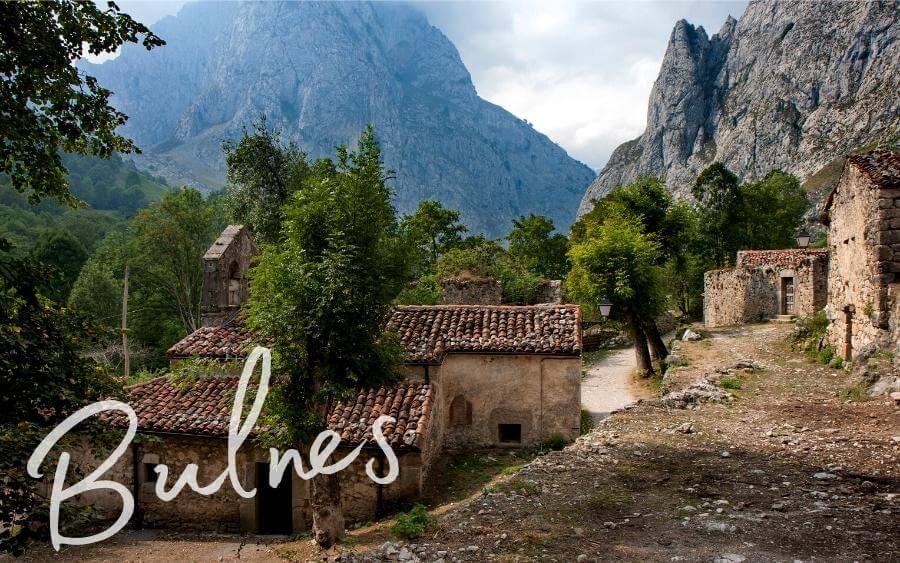
In Asturias in the northern part of Spain, right in the middle of the hiker’s paradise, Picos de Europa National Park, lies the tiny village of Bulnes.
Bulnes is probably one of the smallest villages in Spain, with just 34 inhabitants. Before 2001, this mountain settlement was truly isolated: You could only reach it by hiking on mountain trails. There’s now a funicular that will take you up – but don’t worry, Bulnes remains a gem of a preserved village.
As soon as you step out into the village, you’ll be taken aback by the beauty of the stone houses and by the raw nature all around. Bulnes is set in the middle of the Asturias mountain range, with towering peaks including the world-famous climber’s mecca El Naranjo de Bulnes (aka Picu Urriellu) right on its doorstep.
The village itself is split into two parts: Bulnes de Abajo, or lower Bulnes, which is the first part you’ll reach, and Bulnes de Arriba, or upper Bulnes.
Most people stop in lower Bulnes because you can’t see the upper part of the village; but you should definitely continue further up the steep trail. You’ll be rewarded with absolutely epic views of the valley below, best accompanied by a cold drink from the Bar Mirador Lallende which overlooks the landscape.
Bulnes is the perfect Spanish village to visit when you want to escape the crowds and busy hustle of the city. Stay for a few nights to make the most of the many hiking trails.
By Kevin from KEVMRC
7. Mijas, Andalusia: ONE OF THE MOST BEAUTIFUL WHITE VILLAGES IN SPAIN
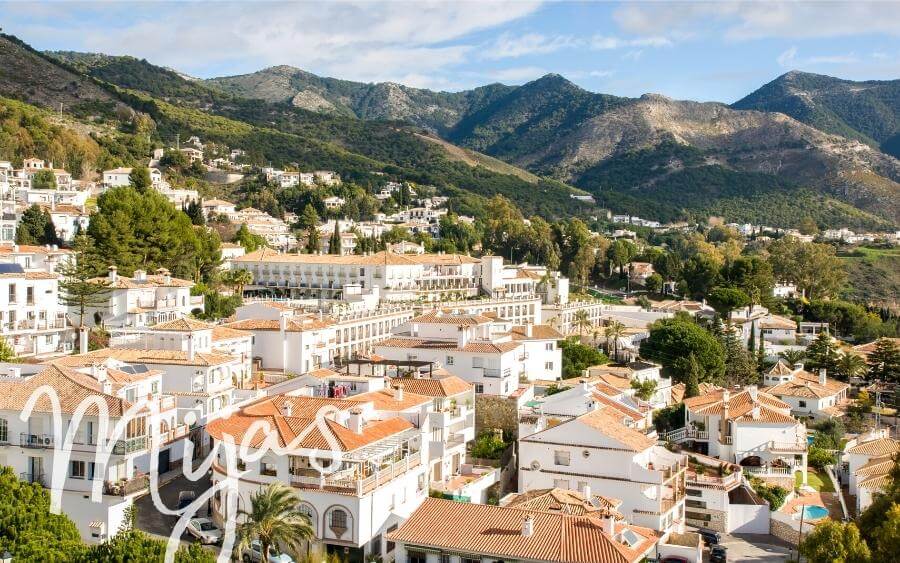
If you’re on the lookout for small towns and Spanish villages and you find yourself in the Costa del Sol, be sure not miss out on Mijas.
Looking at a map of Spain, you’ll see that Mijas is actually a municipality made up of many different parts. I recommend you get to the whitewashed hillside village that is situated in the mountains between Benalmadena and Fuengirola.
For many years this quaint village has offered curious travellers breathtaking views and an insight into authentic rural living. Make sure your Spanish conversation is up to scratch, though, as you will most likely need it when talking with locals.
Whether you arrive during the day or in the evening, you won’t be disappointed. One popular activity is to take a horse carriage ride around the cobbled streets and stop at one of the many restaurants for a bite to eat or to browse one of the many souvenir shops and pick up a unique gift.
To make the most of this charming village, it’s a good idea to arrive in the late afternoon or get there in time for sunset. All in all, Mijas is one village in Spain you can’t afford to miss if you find yourself looking for a break from the beach.
By Daniel from Layer Culture
8. Pampaneira, Andalusia

Las Alpujarras is a mountainous region in the south of Spain full of quaint towns and historic white-painted villages. Pampaneira is one of the most popular villages within the Granada area of the Alpujarras. It’s the first village you come across when travelling up the steep streets in the Poqueira gorge, with Bubión and Capileira located higher up.
The Spanish villages of the Alpujarras are known for their unique houses, which are square in shape with a flat roof and a distinctive round chimney, similar to those found in the Atlas Mountains in Morocco. The streets are narrow and winding , sometimes with fresh water flowing down the middle.
All of this is a throwback to the history of the area, when the Berbers from North Africa settled here after the Moorish invasion in 711 AD. In the late 1500s they were forced out by the Catholic Monarchs and the area was re-settled by Christians.
While the surrounding mountains can be covered in snow in wintertime, the villages themselves rarely see snow, making both a winter and summer trip possible. In summer there are many more visitors as the area is popular with hikers. It’s possible to walk between the villages in the Alpujarras, passing amongst the terraced farms that are watered by snow melt.
Although Pampaneria is home to just over 300 people, you’ll find plenty of restaurants and craft shops selling locally made rugs, ceramics, and clothes. Spend some time here finding a unique souvenir to take home.
By Sonja from Migrating Miss
9. Guadalest, Valencia
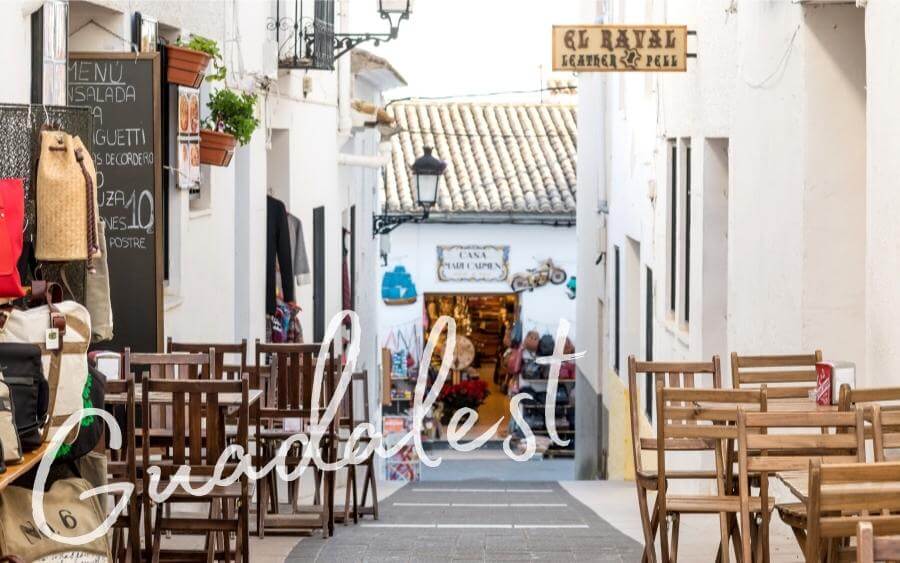
No one could describe most of the Costa Blanca as beautiful. But head into the mountains above the coast and you’ll find the gorgeous village of Guadalest. This is perhaps the most-visited village in Spain (especially on hot summer days), and that’s because it’s a convenient day trip from Benidorm or Alicante.
Guadalest is a fortified village that sits on top of a granite mountain. In order to enter the upper village, you have to walk through a tunnel cut into the stone. It dates back to when the castle was built during Spain’s Moorish occupation in the 12th century.
Guadalest has a long and somewhat convoluted history – there were a lot of owners, several earthquakes that destroyed the village and wars, with the castle eventually being bought by the town in 1994 and turned into a museum.
Today, the village of Guadalest has just 300 permanent residents. If you stay after the day-trippers have gone home, it’s a gloriously quiet place to watch the sunset over the Mediterranean Sea.
There are stunning views to the mountains and the coast, and a series of somewhat strange museums (from a museum of torture, to one dedicated to salt and pepper shakers). The streets of Guadalest are narrow and cobbled, there are artisan shops with local products and a great mix of cafes and restaurants.
Come for peace, quiet and Mediterranean charm; stay for the local food and wine.
By Sarah from A Social Nomad
10. Xativa, Valencia
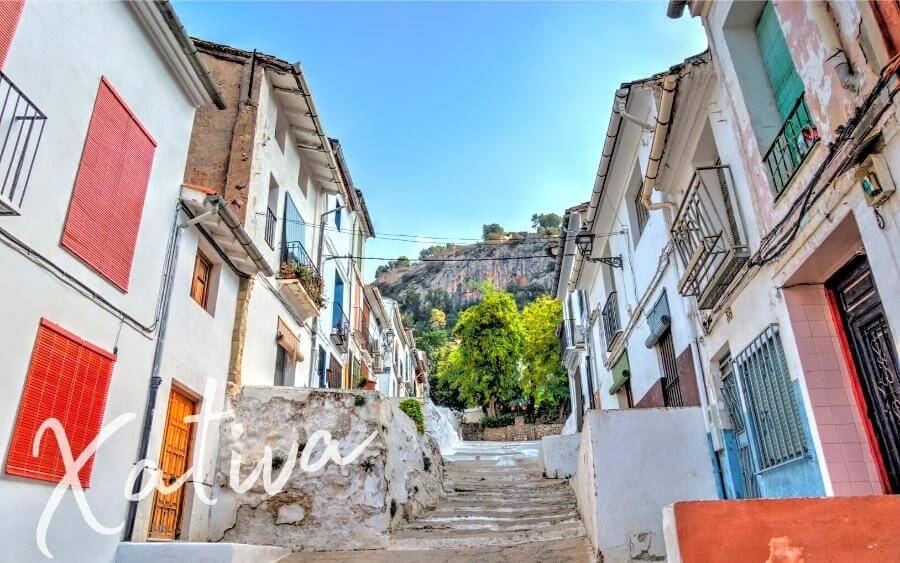
Xativa is one of the most historically and culturally rich towns in the Valencian Community and one of the top day trips from Valencia. Plus, it’s the hometown of one of the most influential families of the Middle Ages, the Borgia.
The Borgia family was one of the most important families of the Renaissance, giving the world two popes and a saint. You can explore the city through all the places related to the family, such as the palace where Alexander VI was born.
The Xativa Castle, however, is the main attraction for any first time visitor. The castle is divided into two parts. Castell Menor, which looks to the east, is of Iberian construction and was the origin of the fortress. Located at a higher level, Castell Major, built later in the medieval period, offers incredible views.
Towards the north, you can see the city and the banks of the Jucar river. To the south, the Mariola, Grossa and Benicadell mountains. Towards the west, the border with the community of Castilla La Mancha. And to the east, when you have good visibility, you can get to see the Mediterranean Sea.
Since 1999, Xativa has changed its appearance every December to accommodate the largest nativity scene in Spain, which occupies 1,600-square-metres. It recreates numerous scenes with life-sized figures made by fallero artists and is completed with elements such as fruits, vegetables or live animals. The nativity scene is even more beautiful at night since it has lighting designed to highlight its smallest details.
By Laura from Travelers Universe
11. Santillana del Mar, Cantabria
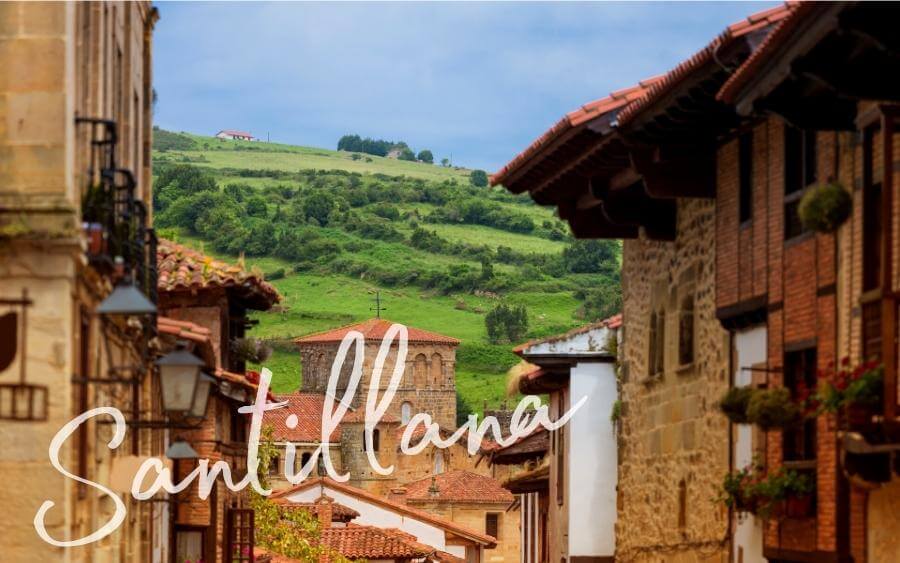
One of the most charming small towns in Spain is Santillana del Mar. The town is located in the province of Cantabria about 30 minutes by car from Santander. It’s therefore very easy to visit if you’re doing a Northern Spain road trip.
Santillana del Mar was given historical status in 1889, however, the town’s name was first mentioned in 1326. It’s known as ‘The Village of The Three Lies’ as it’s not holy, nor it is flat or very close to the sea. Nonetheless, it’s very pretty and definitely worth a visit.
The best thing to do in the town is park your car and walk around. Santillana del Mar is small, so you won’t get lost and in two or three hours you’ll be able to see pretty much everything. Be sure to buy a few local souvenirs and grab a bite in one of the local cafes.
Some of the main highlights include the Collegiate church and cloister of Santa Juliana, Merino Tower, and Regina Coeli Diocesan Museum. The famous prehistoric Altamira cave is also located nearby.
By Liza from Tripsget
12. Arcos de la Frontera, Andalusia
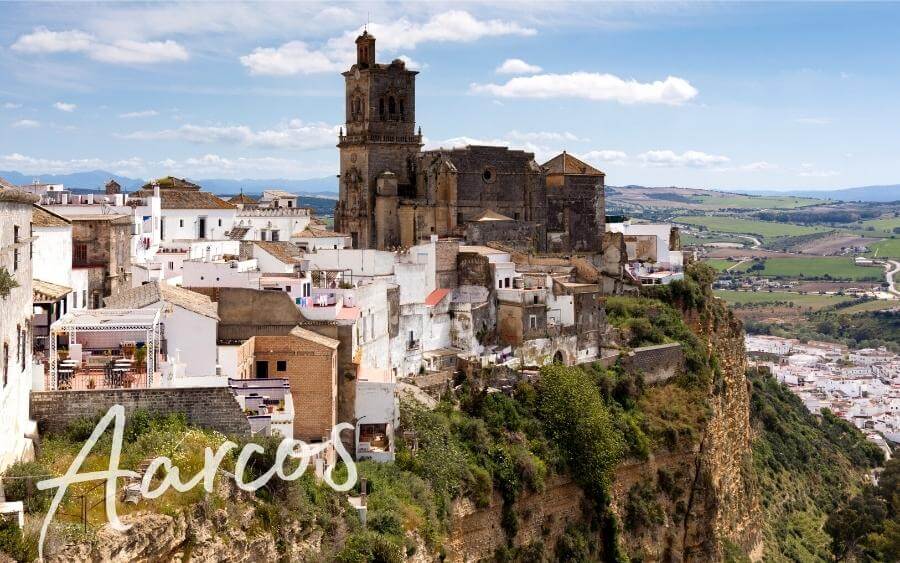
The iconic little town of Arcos de la Frontera in Andalusia forms one of the Pueblos Blancos, or white villages, for which this area is renowned. The beauty of this quaint village is that it is untouched and unhindered by troops of tourists, adding to its authenticity.
Churches and buildings are reminiscent of the Reconquest and Moorish times dating back over 1000 years. Other villages which comprise the Pueblos Blancos are a short drive away but are best explored on foot. Visit the Guadalete river and watch from a hill as the local herds of ibis gather in the shallows. Satisfy your sweet tooth with freshly baked goods from Convento de las Mercadarias in the city centre.
The village retains a combination of its Arabic, Gothic and Spanish heritage and the old town in the centre has been declared Property of Cultural Interest. Visit the Ducal Castle, a Muslim fortress from the 15th century, as well as the Basilica of Santa Maria de la Asuncion, built in the 13th century and declared a Historic-Artistic monument.
Most of the vegetables and pulses used in local food are grown in the village itself, and the region is also home to some of the best wines on an international scale.
By Chrysoula from Travel Passionate
13. Sitges, Catalonia
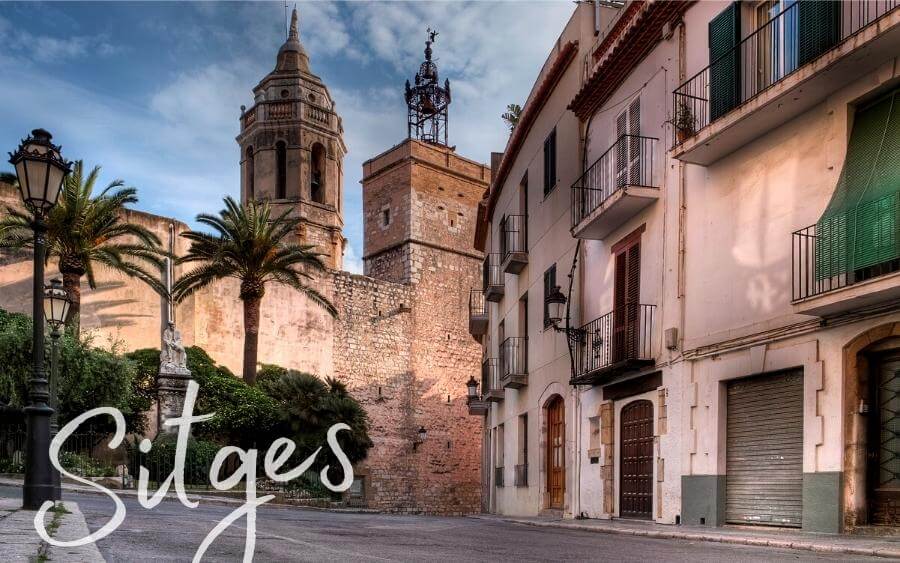
Travel around 30km south of Barcelona and you’ll find the tiny coastal town of Sitges. This quaint little area is a popular weekend destination for Barcelonians thanks to its many sandy beaches. It’s also the centre of Catalonia’s LBGTQ community, where members can feel safe expressing themselves.
If you translate the word Sitges, you’ll see that it means ‘silo’, which refers to the underground containers that were used to store wine here. Before becoming the tourist hub it is now, Sitges was a fishing village known for its wine production, shoe making, and bustling art scene.
It is home to what locals now call Americanos, or successful Catalan entrepreneurs who emigrated and returned to Sitges, the most famous being Facundo Bacardí, founder of the largest rum-making company in the world.
The first hotel opened in Sitges in 1916 and along with it came the tourism boom. Later, a 2.5km sea promenade was developed and lined with palm trees. After a slight hibernation during the Civil War, tourism picked up even more and 75% of residents moved from shoe making to tourism. The highway to Barcelona which opened in the 90s helped to attract more visitors.
New hotels popped up, along with restaurants, bars and boutiques and some brilliant annual festivals. In fact, there are now around 50 events in Sitges every year, from the Film Festival to Gay Pride Week.
While the best things to do in Sitges involve the beach and festivities, there are also some fantastic sites like Palau Maricel palace, Casa Bacardi (if you’re a rum fan) and wandering around El Cap de la Vila. One tip is to go up to the top of the bell tower at the Church of St. Batholomeu for the most amazing sunset views.
By Mar from Once in a Lifetime Journey
14. Ronda, Andalusia
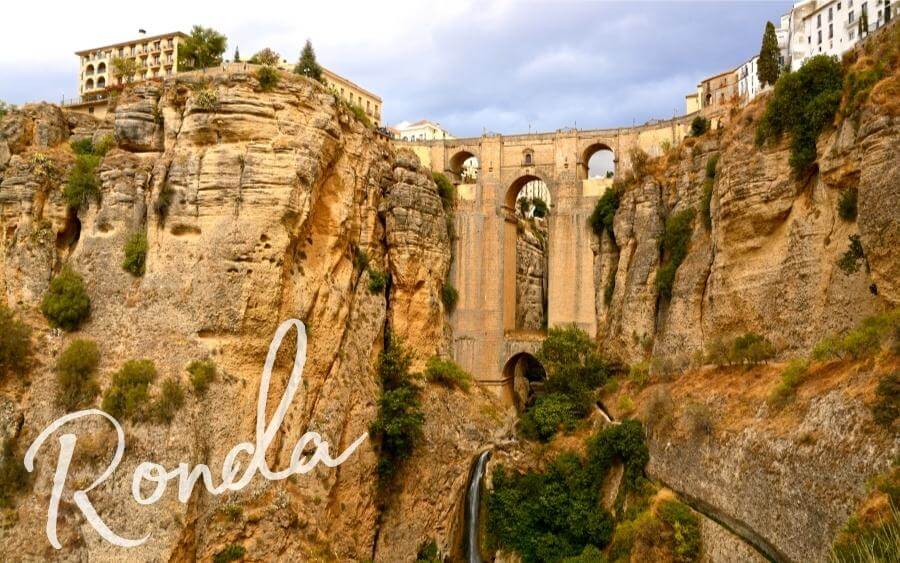
Ronda lies in the culturally captivating Andalusia region of southern Spain. This ancient town has lured visitors for centuries – first invaders hoping to force their way into the citadel, and more recently the likes of Ernest Hemingway and Orson Welles.
It only takes a quick stroll around the streets of Ronda to see why it still attracts people from all around the world to this day.
The town’s crown jewel is the El Tajo Gorge, a 100-metre-high limestone cliffs chasm topped with a bridge that joins the two parts of the city. The Puente Nuevo (New Bridge) is in fact far from new – it was built more than 200 years ago. From the bridge you can gaze down into the gorge, or the more active visitor can hike down to look back up at the bridge.
A visit to the Arab Baths is another wonderful thing to do in Ronda. These 13th century baths are no longer in operation, so visitors can wander through the former bathhouses and aqueducts. The star-shaped vents in the vaulted ceiling let in shafts of natural light.
Another highlight is the Cuenca Gardens, set on top of a craggy gorge. These gardens are a lovely respite during the heat of the day or to relax weary feet.
While there are dozens and dozens of beautiful small towns and villages throughout Spain, Ronda is undoubtedly one of the most magical.
By Rebecca from Rebecca and the World
15. Nerja, Andalusia
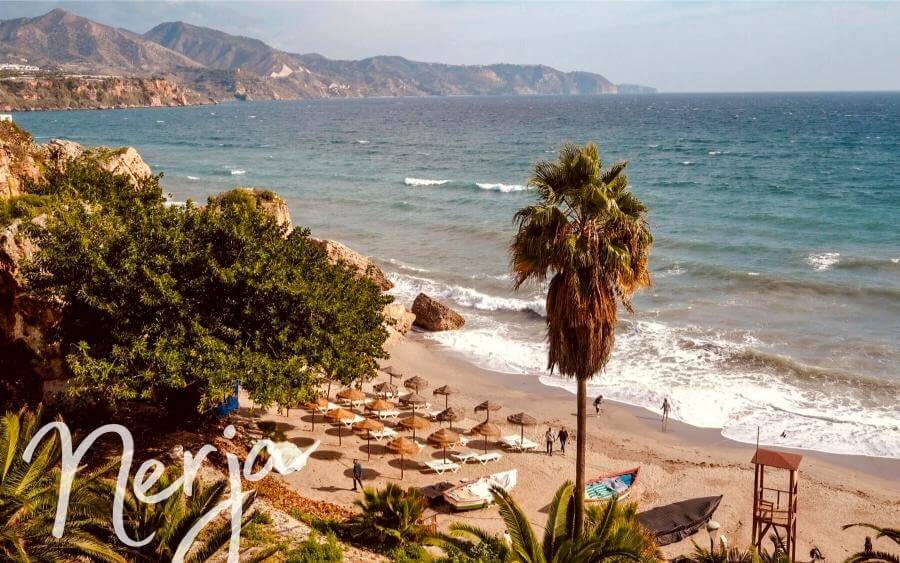
Nerja, pronounced ‘nair-ha‘, is a treasure of a Spanish village on the gorgeous Costa del Sol in southern Spain. It’s situated directly on the turquoise Mediterranean Sea. While most tourists head to nearby Malaga instead, Nerja makes a wonderful alternative for those seeking a smaller, more walkable village without the crowds.
It’s beaches galore in Nerja (look for the seller serving paella from a giant pan at lunch time directly on the beach. He’s there somewhere!) As you wander through the village, be sure to stop at the Balcony of Europe (Balcon de Europa) in the very centre. Snap a photo next to the statue of King Alfonso XII who named the balcony after a massive earthquake shook Nerja in the 19th century.
Nerja’s balcony provides an orientation to the village with Insta-worthy ocean views. To your right, you’ll see Caletilla Beach and to your left and Calahonda Beach (also known as Hotel’s Beach). It’s important to note, however, that beach access is not straight forward in Nerja. Visitors who are not staying at a beachside hotel will need to do some walking to actually get onto the shore.
Nerja makes for the perfect ‘vacation from your vacation’ between larger cities such as Barcelona, Sevilla and Madrid.
By Chris from Explore Now or Never
16. Plasencia, Extremadura
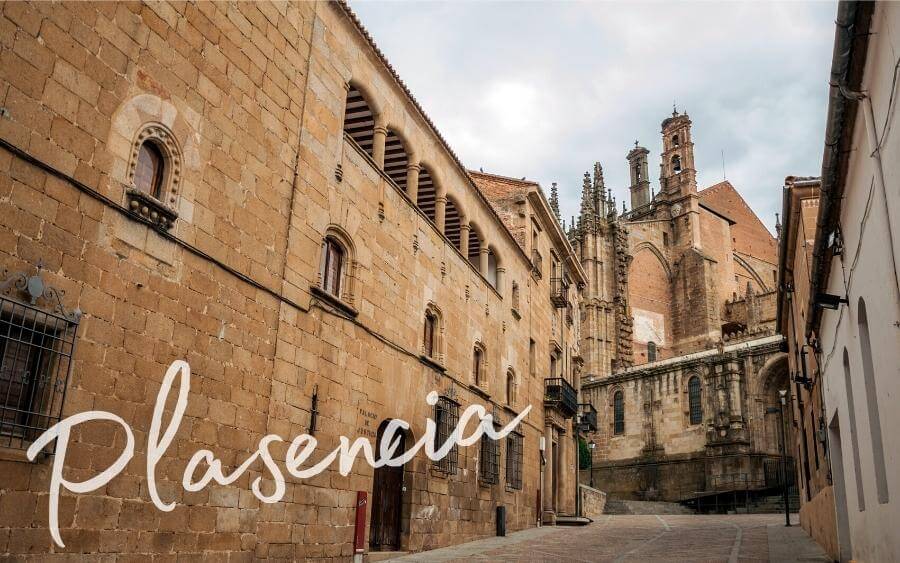
For those wishing to get away from over-touristed destinations in Spain and experience what life is like in an authentic Spanish town, Plasencia is a great option. Located in the remote Extremadura region in the far west of the country, not many tourists make it out here. But that’s not because Plasencia doesn’t have any sights to offer.
On the contrary, this medieval town is filled with stately mansions built by the conquistadores who set out to conquer the New World and plunder its riches. Once a hive of activity thanks to its prime location on the Vía de la Plate (the Silver Way) trading route, Plasencia today is a quiet, unassuming town that still has some impressive sights left over from bygone eras.
The cathedral, the city walls and the towers and gates that punctuate those walls are definite highlights. Inside one of these towers is the Interpretation Center of the Medieval City, which offers some background information about the area’s history as well as some spectacular views from on top of the walls themselves.
When it comes to accommodation in Plasencia, the hands down winner is the Plasencia Parador. Once a 15th-century monastery, this historic building has now been converted into a luxury hotel. And because all Paradores are State-run, the prices can be surprisingly affordable.
By Wendy from The Nomadic Vegan
17. Sa Tuna, Catalonia
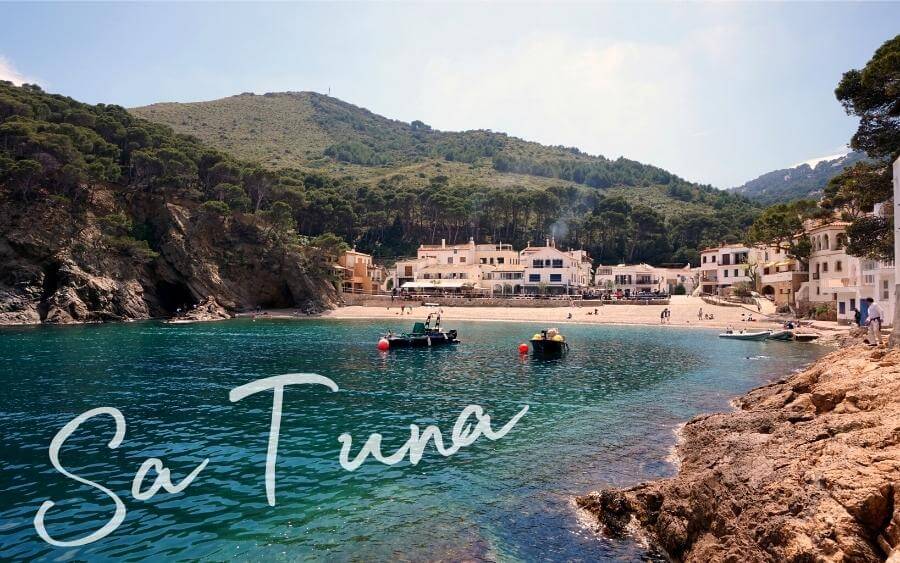
The tiny fishing town of Sa Tuna could easily be overlooked in favour of larger and more popular Spanish villages and towns on the Costa Brava. But there are many reasons why you should seek it out! Located near the historic hillside village of Begur, this former fisherman’s port is a charming day trip from Barcelona.
The road to Sa Tuna is long and winding, and admittedly, there’s not a whole lot to do once you arrive, but the scenery is out-of-this-world beautiful, and the surroundings are even more magical. Arrive early in the day to nab one of the coveted car parks in the village, and bring your walking shoes as well as your swimwear!
Explore the intricate maze of streets that surround the small bay. Peek through gaps in the stone buildings for secret views and enjoy the bright bougainvillaea-laden facades of the tiny hamlet of houses.
Take a walk around the headland to the hidden Cala S’eixugador for a tranquil paddle in a calm bay, or in the opposite direction to the stone stairway that will lead you down to Cala Ses Vaques. At the end of the day, settle into one of the seaside town’s bars for a refreshing drink or dinner accompanied by sumptuous views.
By Nadine from Le Long Weekend
18. Garachico, Canary Islands
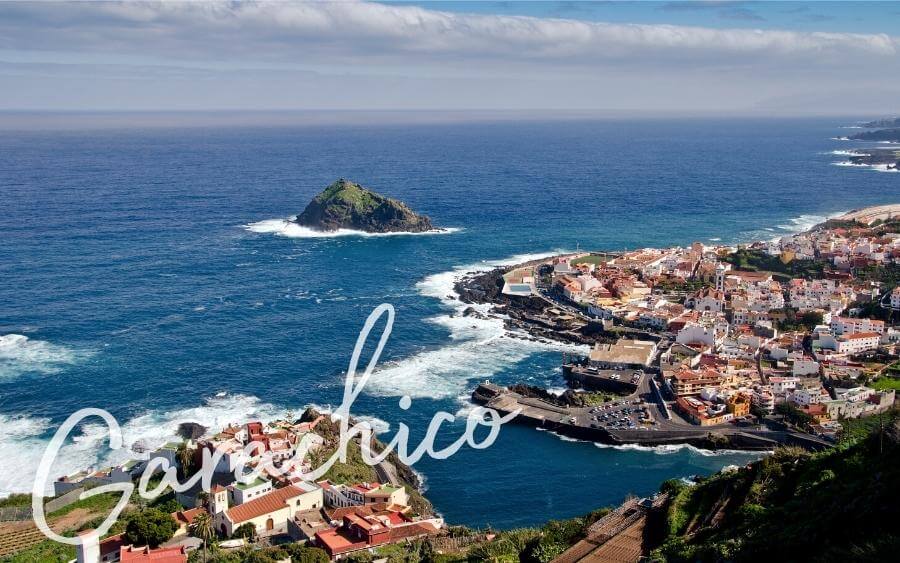
The coastal town of Garachico on Tenerife’s northern coast was once the island’s most prosperous port. Founded in the 15th century by Genoan banker Cristóbal de Ponte, it was a major crossroads of European and African trade – that’s until a volcanic eruption in 1706 changed the course of history.
Over several weeks, lava flowed into the bay, making it possible for ships to dock and ruining the town’s livelihood. Part of the town centre was also destroyed. Despite the hardships, Garachico has gone to great lengths to ensure its most precious cultural and natural assets were always protected – and as tourists, we can enjoy them today.
In the historic quarter, there’s the Plaza de la Libertad, the town’s main square, Parroquia de Santa Ana church, and towering above, the mighty Castillo de San Miguel. To the west, you can get postcard-perfect views from the Mirador del Emigrante, hike the Charco de Los Frailes trail along the water’s edge, or swim on the little Playa de Garachico beach. Don’t miss a boat trip out to the Rock of St. Michael, a volcanic formation with sea caves.
Less than an hour’s drive from the capital, Garachico is a welcome break from Santa Cruz de Tenerife and a wonderful place to learn about the island’s history.
Hiring a car in Spain
The best way to travel around Spain and access some of these smaller and more remote Spanish villages and towns is by hiring your own car. This is exactly what we did when we spent three weeks travelling around Spain.
I highly recommend using Discover Cars to compare prices and features across a range of local and international rental companies. Check Spain car hire prices on Discover Cars.
Finding accommodation in Spanish villages
Spanish villages are home to some of the nation’s best accommodations, from spectacular Paradors to charming family-run guesthouses. I recommend using both Booking.com to find hotels and pensions in Spain, plus Airbnb to seek out unique apartments.
Browse Spain accommodations on Booking.com.
Browse my list of Spain’s best Airbnbs for inspiration.
More destinations to discover
- Best cities to visit in Spain
- Best places to visit in Portugal
- Best cities in Italy
- Best places to visit in Slovenia
- Best places to visit in Croatia
- Best places to visit in Montenegro
- Best cities to visit Romania
- Best places to visit in Turkey
Which of these Spanish villages makes your wish list? Are there any more villages or small towns in Spain you would recommend to visitors?
Beautiful Spanish villages: Pin it
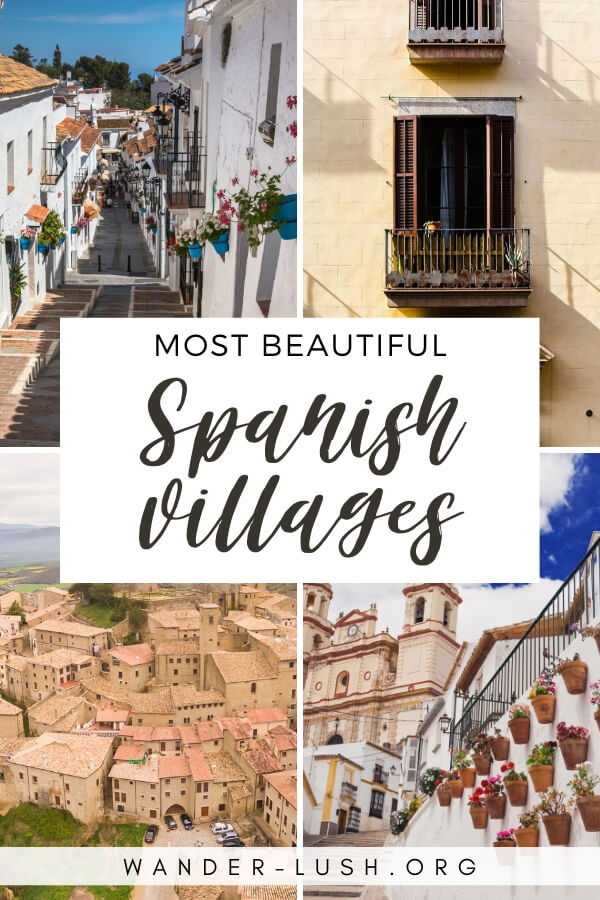
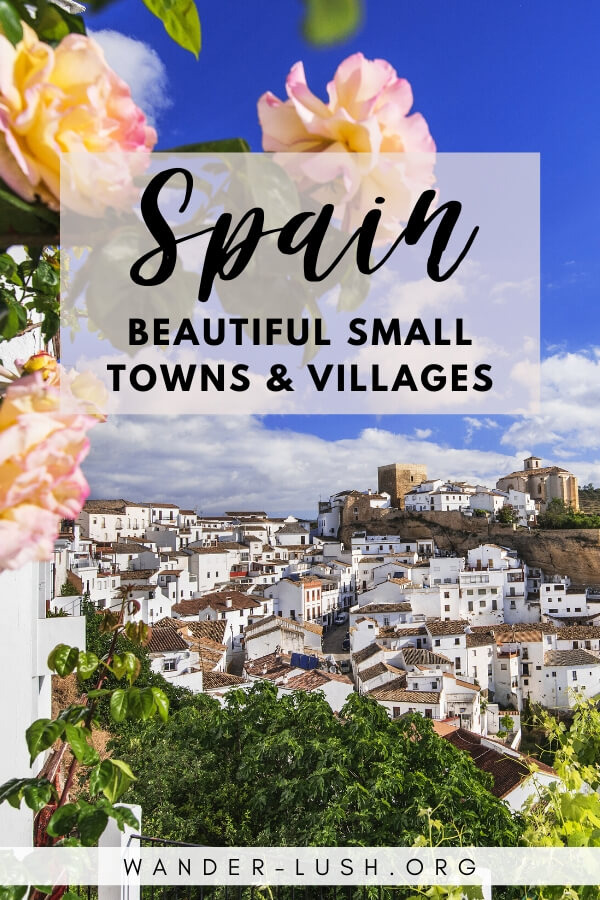
Nothing from Mallorca.. there you can find some beautiful villages too… Valldemossa, Deia, Banyalbufar, Fornalutx… Mijas is beautiful, and from the white villages I liked Grazalema too.
Terrific suggestions!
Having gone to school as a foreign exchange student in Valencia, I have great memories of Spain. Now that I am retired, I am researching Spanish countries to move to for financial reasons. From my research, many Spanish countries/large cities are loud, barking dogs etc which contradicts my idea of a nice quiet retirement. Can anyone recommend a small “quiet” city in Spain, but with accessible healthcare? Thanks
Check out Begur in the Costa Brava. We were there in the off season (February 2019). Very quiet. May be noisy in the high season but I suspect not too bad. The barking guard dogs you speak of can be found where city folk leave their dogs in a second home- not too well cared for and can be startling while on a walk. We lived in Casteldefels (near the airport in Barcelona) and this was the case. Fun place, though!
Thanks for the suggestion, Paul!
Hello thank you for the great information and beautiful pictures! We are a family of Americans with roots in Spain. Our mother was born there in the region of Santander and our father in Zaragoza. We want our kids to spend the month of July in Spain learning the castillian language. It would be nice to be where the summers are not too hot and near a beach for the children. We would rather be somewhere quaint with driving access to a larger city. Please advise. Regards!
Plasencia and the other little towns above the rivers valleys are a must visit in Spain.
Thank you for the recommendation!
Ronda is my favourite from the list, called the city of romantics 😉